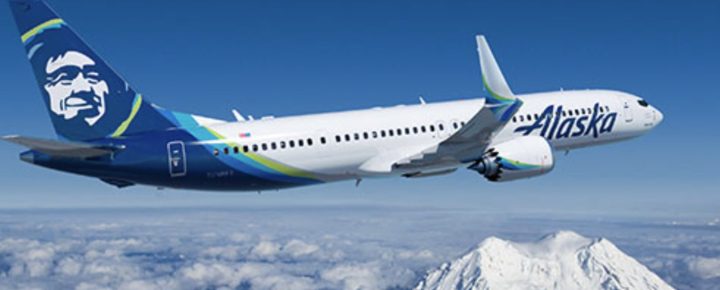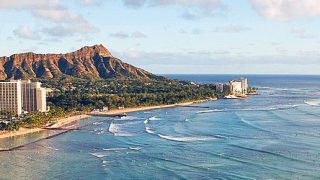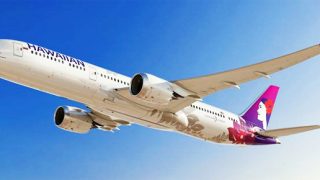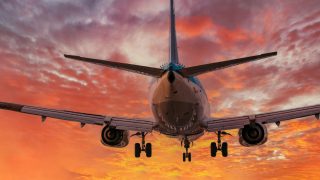The same Alaska Airlines Boeing 737 MAX 9 plane which suffered a mid-air window blow out and depressurization and was forced to make an emergency landing at Portland (PDX), has recently flown extensively between Hawaii and the mainland. At the time of the incident, however, the plane was climbing towards cruising altitude en route from Portland to Ontario.
What would have happened if this incident had occurred on a Hawaii flight? Read on for more on that.
The airline subsequently grounded its entire 65 plane fleet of the variant. CEO Ben Minucucci announced “Following tonight’s event on Flight 1282, we have decided to take the precautionary step of temporarily grounding our fleet of 65 Boeing 737-9 aircraft. Each aircraft will be returned to service only after completion of full maintenance and safety inspections. We anticipate all inspections will be completed in the next few days.”
Given these planes fly regularly to and from Hawaii, we’ll also be on the lookout for any impact the temporary grounding may have on these routes.
We tracked all the flights to and from Hawaii on this particular aircraft, which has a registration of N704AL.
The Boeing 737 MAX 9 plane was delivered new to Alaska in late October. On October 25, it received its FAA certificate of airworthiness. It began making regular passenger flights on the mainland in November. However, it didn’t start flying to and from Hawaii until late November, as seen below.
The list of recent flights to and from Hawaii on this plane is as follows:
- Los Angeles to Honolulu November 21
- Honolulu to Seattle November 21
- Seattle to Maui November 22
- Maui to Seattle November 22
- Kona to Seattle December 8
- Seattle to Kona December 8
- San Francisco to Honolulu December 11
- Honolulu to San Jose December 11
- San Jose to Kona December 12
- Kona to Seattle December 12
- Seattle to Kona December 13
- Kona to Seattle December 13
- Portland to Honolulu December 18
- Honolulu to Anchorage December 18
- Seattle to Honolulu December 19
- Honolulu to Seattle December 20
- San Diego to Honolulu December 23
- Honolulu to San Francisco December 23
- Portland to Honolulu December 24
- Honolulu to Anchorage December 24
- Anchorage to Honolulu December 26
- Honolulu to Seattle December 27
This plane made an emergency landing on Friday night when a portion of the aircraft, including a window and panel, blew out in flight, causing rapid depressurization. The affected area was an optional emergency exit that Boeing had converted to a window as a driver option. In images and videos, the impacted area resembled the entire emergency exit.
The plane lost pressurization, and the pilot reported, “We’re declaring an emergency.” The FAA said, “Alaska Airlines Flight 1282 returned safely to @flyPDX around 5 p.m. local time on Friday, Jan. 5, after the crew reported a pressurization issue. The aircraft was traveling to @flyONT in California. The FAA and National Transportation Safety Board (NTSB) will investigate.”
The aircraft was climbing when the issue occurred.
An airliner can lose pressurization at any phase of a flight, be it climb, descent, or cruise. This can occur either if there is a failure of the pressurization system or due to any structural issues related to cabin pressure, such as appears to have been the case with the Alaska flight.
Airline flight crews are well-trained to handle these situations, and as passengers, we’re routinely informed about safety procedures, including the use of oxygen masks in the event of such a loss of cabin pressure. This incident certainly brings safety procedures home for us.
Fortunately, the plane landed safely, and kudos to Alaska Airlines and the crew on the flight. Alaska maintains the highest safety rating of any US airline, as we reported this week!
Additional concerns present on Hawaii flights with longest span of open ocean without diversion points.
Flights to Hawaii differ from mainland flights for this reason. They are some of the world’s longest overwater flights anywhere without a diversion point since Hawaii sits more than 2,500 miles from the nearest point of North America. Hawaii flights can be up to three hours from the nearest diversion airport. For these reasons, safety takes on an additional meaning.
The Alaska plane asked to descend to 10,000 feet due to the lack of pressurization. In the brief remaining flight time, that did not present an issue. But would the same have been true if the plane had been mid-way between the mainland and Hawaii? Aircraft use significantly more fuel when flying at lower altitudes.
FAA once said that it wouldn’t allow twin-engine aircraft to fly to Hawaii.
“It’ll be a cold day in hell before I let twins fly long-haul over-water routes.” That from the FAA Administrator in 1980 as Boeing sought to receive approval more than 40 years ago.
Since then, twin-engine flights have become the only option on US flights to Hawaii, both narrow-body and widebody.
Decades ago, three-engine jets such as the L-1011 and DC-10 tri-jets crossed the Pacific. But by 1990, the FAA approved the Boeing 767 and 777 twin-engine planes’ ability to fly to Hawaii. And the rest is history.
Aloha Airlines was the first to fly the Boeing 737 to Hawaii.
Still loved Aloha Airlines was the first airline to operate 737 flights to Hawaii back in 2000. With that permission, the entire Hawaii flight scene changed, and narrow-body planes, including Boeing 737 and Airbus A321, now dominate West Coast routes.
Does this incident change your feelings about flying Boeing 737 MAX to Hawaii?
Updated 1.6.23 7 am HST.







As a retired airline mechanic, that’s worked pressurization problems. According to write up if it was wrote up as squealing then as a mechanic you hold up boarding. Shut all doors presurize the airplane till you find the leak. And repair it. If the report not holding then do the same thing. Now if it showed a fault then you bite check the cabin pressure controllers and see what the fault was . And repair it if a no go are Mel it if it can go like it is . The Mel is approved by the faa and the manufacturer. There are 2 pressurization systems
Reports are now starting to surface of United finding 5 aircraft with loose bolts on the door plugs. It just seems that Boeing aircraft had far fewer problems when all aircraft were built in Boeing factories in Washington. Ever since they started parting out manufacturing to other companies, and opening the assembly plant in SC, there have been nothing but headaches and quality control issues.
Interesting report on BBC from NTSB that Alaska had restricted the routes for the Boeing plane involved after pressurization warnings in the days before the event.
Pilots had logged warning lights on three previous flights, said Jennifer Homendy of theUS National Transportation Safety Board (NTSB). As a result, the airline prevented the jet from making long-haul flights over water, Ms Homendy said.
Good news for Hawaii travelers but should Alaska have continued to fly equipment with a recurrent warning of a potentially serious fault? I guess the NTSB will tell us all, so we wait to see.
FYI the 737 Max9 and the 737-900 both have the plugged exit. The -900 has flown for 20 years with many airlines without incident.
Flying to Hawaii in May. Big island
Getting concerned with flight delays and flights having so many turn around and emergency landings.
Canceled maui last year as our condo near fire area.
I have till March to cancel accommodation and not booked flight yet.
I’m pretty nervous about my upcoming flight but I don’t know for certain that is a 737 Max 9 because I cannot access my reservation on the website. If you look at future flights from LAX to OGG they all show American Airlines not Alaska on the Alaska website.
Hi Nancy, I believe the FAA is grounding all 737 Max 9s across all United States airlines following this incident. You should be fine. Enjoy Hawaii! Local businesses need some love in Hawaii.
I will definitely chose an isle seat if I fly. I was on a SD to Kona flight in December but not on that particular aircraft.
Had that incident occurred in the middle of a Hawaii route, is it conceivable that the plane could have descended to 10K and flown at that altitude all the way to the nearest airport? Do they carry enough fuel for that?
Yes they do…in fact it’s an FAA requirement that they carry enough fuel to fly at 10,000′ to the nearest suitable airport (with good enough weather to land) at any time during the flight based on winds that it will encounter on that particular day. That’s why on some flights with the older generation 737’s they bump passengers and/or cargo on days with strong headwinds. They need to carry enough fuel to conform to that requirement. It’s not something that be be scrimped on
Sure glad that did not happen on a trans-Pacific flight. The outcome would have been much different. Hawaii flights typically fly at between 34000-40000 feet. Pilots ascend quickly to the cruise attitude to save fuel. It would take a pilot about 10-15 minutes to descend to 10000 ft from 35000 and the aircraft would be in a dive on the way down.
Very unfortunate accident last night. I’ve flown in Boeings from 1960 on. There used to be a saying: “If it ain’t Boeing, I ain’t going”.
My spouse retired from Boeing about 6 years ago. The motto amongst the employees during his time was “we make them fly despite management”. Still, I’d prefer Boeing over Airbus.
I only guess, 10’000ft is still pretty high up and I am sure they carry enough fuel to get to the closest point, depending at what point they are when the emergency occurs. They may have to turn around or continue directly to the destination. It’s something that the engineers will figure out now. I still love those aircrafts. I think they are very comfortable and quiet compared to other models.
Their new motto is “Boeing: When one door closes, another opens”
Oh David!
Aloha.
Do you know what time the flight was from Sea to Kona on 12/13??
Maybe on the Max 9, but not the Max 8. Boeing’s safety/inspection procedures are again in the news following the MCAS problems five years ago. I read that airlines can choose to insert a “plug” where the extra emergency exit would be if they opt for a lower density version of the Max 9, which apparently Alaska did. Alaska and United are the only US airlines flying the Max 9.
It does sound like it’s a an emergency exit window issue. these things do happen, kudos to the crew and Alaska’s response…they jumped on it and parked the airplanes before the FAA mandated doing so.
Hi John.
Thanks for that. Can you comment on a scenario of half way across the pacific at 10k feet. What about temperature, wind, noise and other conditions. Thanks!
Aloha.
Well it would certainly be an unpleasant flight! But as I said elsewhere all flights have to carry enough fuel to make it to a suitable airport from 10,000′ at any time during the flight and this is calculated by the dispatchers individually for every flight based on the days temp and wind conditions. With any kind of structural damage it would also be at a somewhat reduced speed….so a long and uncomfortable ride to say the least and if closer to Hawaii you would likely end up in Hilo as it’s the closet airport to the tracks between Hawaii and the mainland.
Hi John.
Thanks!
Aloha.
This type of incident is definitely an extreme outlier and while possible, it is extremely concerning and should not occur. Unless of course you consider Boeings recent safety record, in that case maybe it is something that happens with Boeing, it seems as though they have some real QC issues for this to occur.
It cannot be stressed enough how many lives could have been lost if this had occurred 15 minutes later at about 32,000 ft. People walking around, drink service, seat belts off, much faster/rapid decent to get to 10,000 ft instead of the more controlled and slower descent from 16,000 ft.
It’s a little concerning that it was in an area if optional emergency exit that Alaska chose not to have. Perhaps their design to eliminate exit door and put a window was flawed – or not done to spec. Quality Control must be difficult on aircraft as inspections can only show some issues. However it’s likely an issue across all planes. Still haven’t flown a Max, but I likely will have little choices.
It was because Alaska chose to have a lower passenger count that did no require the extra emergency door. So Boeing put in a plug. Now that requires a back check by a QA inspector. He inspects the installation. If the bolts are Torque then the inspector will witness the proper Torque . Then they will sign for the inspection . The mechanic signs off the plug installation. I’m at retired airline mechanic. And almost any time you work on a door an emergency exit are plug. It requires the back check. Also Boeing dose a pressurize the cabin and checks for leaks. Plus also flys the airplane as well as Alaska pilots will goto Boeing and fly the plane before it’s delivered to fix any writeups that are wrote up.
I frequently transverse the Hawaii to Mainland route (often avoiding the West Coast as my travels take me further East) and recall always saying to myself in the L-1011/DC-10 days that I will never fly two engines on distances of that length for the obvious reasons already cited and similarly expressed by the previous FAA Administrator. But now I have no choice. Yes, pilot training, technology, (aircraft redundancies), and safety protocols have come a long way but …. as the article implies, all it will take is one mishap before rethinking occurs. Profit margins? Safety cannot be taken for granted. One life lost is already too many. I quietly say my prayers each time before the flight departs that I may return safely to my beloved family.
Chg no, its a death plane designed by cut rate incompetents to fatten mgt and wall st pocket aka the death planem kllled 347 ppl and the count will only go up.
Build quality at ba has been going down hill since wall st and cliton forced douglas merger. Faa the day b4 issued a directive to check that blots are correctly thightened. Clearly ba is rushing these planes out the door before qa is fully done.
This article raises the interesting question about how such a blowout would affect a flight to Hawaii, but then doesn’t go on to answer it. Would flying at 10,000 feet result in insufficient fuel to complete the trip? Can anyone tell us?
Assume they have enough fuel to complete the trip (or turn back) at 10,000 feet, with cold air rushing in at 400 mph, how long can the passengers stand the cold blast?
I remember the Aloha Airlines 737 that had the roof torn off mid-flight, and they were just going inter-island.
737 max have been a nonoo since they. Started crashing.
I think the key piece of information is that the defect occurred in a customization performed by the airline of an exit door into a standard window. Presumably the strengthening built into the frame for the door had a differing expansion rate to the non strengthened panels. No doubt the NTSB will publish the details.
It is not a customization done by the airline. It’s a factory option from Boeing. However It’s very possible that Alaska mechanics removed the plug door on the brand-new plane to install seats or some other task before the plane entered service
Thank you for the clarification. It will be interesting to see if they did remove the plug to fit out the interior and if so what the Boeing Manual instructs in such circumstances. I remember a previous case where airlines were using fork lift trucks to replace jets on the wing and not following the prescribed instructions was causing the weaknesses which led to accidents on a different aircraft.
It’s not a akaska customization. It’s because they chose to have less seats. Then a plug is fitted where the door would have gone. You can’t put a window there. It’s cut out for a door. So they put a plug the size of door to cover it..
As a pilot it appears the flight crew and passengers performed beautifully during this incident.
Also shows why you should always be wearing your seat belt.
Other than the obvious continued degradation of the plane flying at 10,000 feet over water for prolonged time fuel consumption could become an issue.
Those of you holding Boeing stock are going to take a hit.
“ Those of you holding Boeing stock are going to take a hit.” Having been at Haneda when the A350 collided with a Coastguard aircraft which failed to hold short, I was amazed both by the speed which the JAL crew evacuated the Airbus and then the inferno and subsequent structural failure caused by the fire. The last aircraft fire last that was the Concorde crash which Airbus was also involved with. I suspect now is not going to be a good time for any aviation stocks with these two stories which show both excellent crew behavior as well as questions about the equipment, along with loose bolts and mandatory engine replacements etc.
No. It was a simple plane collision. Airbus 350 or Boeing 787, either would probably have been equally impacted by fire due to the use of carbon fiber in the fuselages of these newer planes by both makers.
Yes, the NHK news reporting said tvat they were allowing it to burn once pax were off was the toxic carbon ash released into the atmosphere when these materials burn. The key issue fir me is the fire crew managed to put out the external wing and outer shell fires then the interior burst into flames and as I said, I have not seen such ferocity since Concorde crashed. The focus now is rightly why the Coastguard plane did not hold but I think it will have raised concerns at Airbus. I have never the structure break and the tail fall off from fire not impact. I flew A350 on Iberia and it was OK and JAL are launching A350 10 on International routes. I am sure the aircraft is airworthy but I will avoid them until changes are made I think.
Aloha! You mentioned that Alaska had converted an optional emergency exit into a window, that window. Who did that conversion? It seems to me that’s where the workmanships comes into question. Despite the problems with the Boeing 727 MAX I’d still fly on them. The crew knew what to do and everyone landed safely. Life’s a gamble on so many other levels.
Hi Susan, per my comments above, it’s an option from Boeing when the airlines order a plane (just like options on your car). The older 737-900 (non-MAX) has the same feature and 552 have been flying since 2001 with no similar problem.
My understanding is airlines prefer the plugged exit option even with fewer than 190 seats. If they sell the plane later on, having the plugged exit is more attactive to buyers with high-density seating where regulations require an exit door (seats and overhead bins at that row are removed).
.its not a window. The cut out is a door. So they put a plug door to cover the cutout . It’s because they did not have the extra seats in the plane. The same on united
This is on top of the loose rudder bolt problem just discovered on these MAX aircraft… What else?
Best Regards